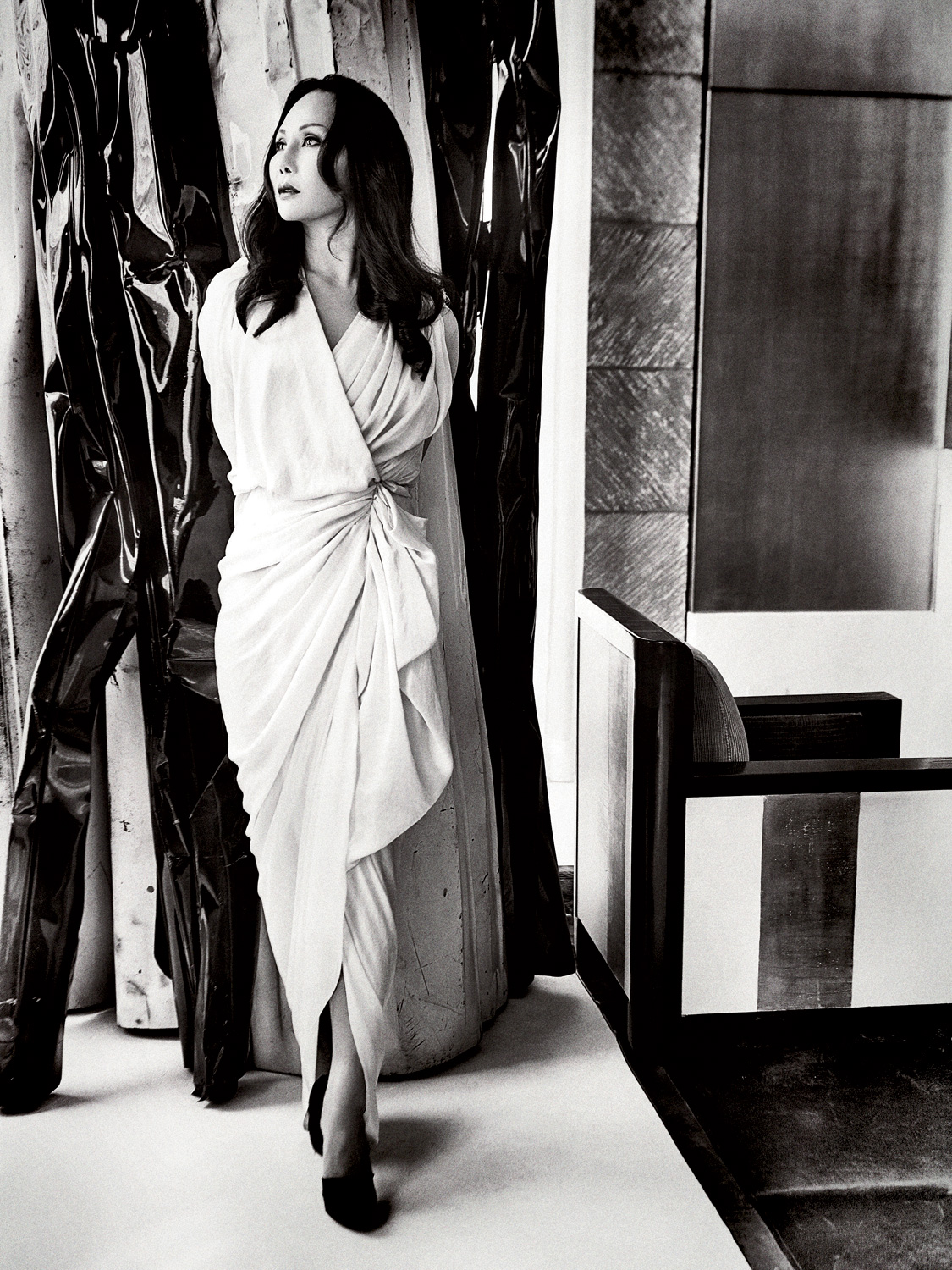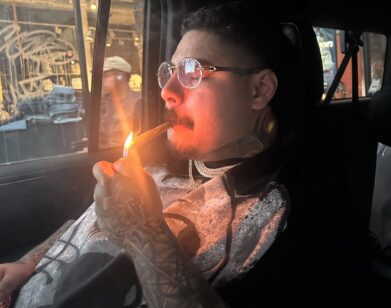Eva Chow and Brian Grazer
we want the film department to be involved in not just the curating of film, but the restoration of films, and in film education. EVA CHOW
On November 5, the Los Angeles County Museum of Art will host its inaugural Art + Film Gala to celebrate what might be called, in Hollywood parlance, a “reboot” of the museum’s 43-year-old film department under the watchful eye of LACMA director Michael Govan and new chief curator (and Interview special correspondent) Elvis Mitchell. LACMA’s film department, founded in 1968 by Phil Chamberlin and artfully overseen for much of its existence by Ron Haver, cheated death in 2009 when rumors of its imminent demise amid a flurry of budget shortfalls drew some prominent calls to action from the film community-most notably from director Martin Scorsese. Evidently, the outcry did not fall on deaf ears: rescue funds materialized from the likes of the Hollywood Foreign Press Association, Ovation TV, Time Warner Cable, and the film department was spared.
However, finding a way to fund LACMA’s film department, at least temporarily, was only phase one of battle-the other was charting its course for the future. Mitchell’s appointment as chief curator last June, replacing well-respected 15-year veteran Ian Birnie, comes on the heels of an announced partnership with Film Independent-the folks behind the Independent Spirit Awards-to reinvigorate LACMA’s long-running weekend film-series programming with previews of new features and documentaries, as well as high-profile retrospectives, guest speakers, and panel discussions. There is talk of high-profile premieres and industry-focused workshops. Education and community outreach is high on the agenda. But beneath it all, the goal appears simple: to re-establish the film department as a solvent arm of the museum by reimagining it as a place that’s not only at the center of the discourse of film as an art form, but at the center of the contemporary film world itself, a lofty ambition in a town where movies-and the movie-making business-have managed to infiltrate nearly every level of the social strata. LACMA’s clearest statement of purpose, though, might be the announced honorees at this year’s Art + Film Gala: John Baldessari, whose groundbreaking work in film and video looms large in the canon of California art; and Clint Eastwood, whose new film J. Edgar, about controversial FBI director J. Edgar Hoover-starring Leonardo DiCaprio in the title role-is set to screen on the night before the gala.
Eva Chow, who is cochairing LACMA’s Art + Film Gala with DiCaprio, recently spoke with one of J. Edgar‘s producers, Brian Grazer, about the gala, the importance of the film department’s new mission, and re-examining the role of institutions like LACMA in both the study and the celebration of the relatively young art of filmmaking.
BRIAN Grazer: How did you go about organizing this event at the Los Angeles County Museum [of Art]?
EVA Chow: Michael Govan, the director of LACMA, and I actually first spoke about it a year-and-a-half ago. Michael’s vision was to do something to put a spotlight on our film department. We have a new curator, Elvis Mitchell, and we’re really just relaunching the entire film department. So this gala is to put the word out there and, at the same time, honor film as an art form-of which it is a relatively new one. So when Michael finally said, “Okay, let’s do this,” I thought about who would be a really great person who could represent the connection between film and art, and I immediately thought of Leonardo DiCaprio. Obviously, Leo is an amazingly talented actor, but he also loves and supports art. So Michael and I both went to Leo with the idea, and now here we are, a year-and-a-half later, and he is cochairing the gala. We also have been able to get a lot of other great people to be a part of our host committee-Dasha Zhukova, Larry Gagosian, Lynda Resnick, you, of course. [laughs] So that’s how this thing is coming around. We also have Gucci as a major sponsor. I’ve had a relationship with them for a long time, and they’re a really great fashion house to work with. So we’re very excited, Brian.
Grazer: What is the plan for new incarnation of the film department? How is it meant to function?
Chow: Well, first of all, we have Elvis Mitchell as a new curator. He used to be a film critic at The New York Times.
Grazer: Yes, I know Elvis. He’s great. He’s reviewed many-if not all-of my movies.
Chow: Good reviews, I’m sure. [both laugh] But I think having someone like him, who understands the film world and also film as an art, as thhe new curator-as well as doing events like this gala, which celebrate the relationship between film and art-will help bring support to the film department, which it really lacked before. Our hope is to also really engage the film community and the community in Los Angeles. You know, Brian, we want the film department to be involved in not just the curating of film, but the restoration of films, and in film education. I think the involvement of a person like you, for example, can certainly help a lot of ways in influencing how the film department organizes their programming. We’re making an effort to involve some very influential film-world personalities with the museum. Not to mention that we are in Los Angeles, the heart of film-land.
Grazer: Yes, at the epicenter of where a lot of film and television is created.
Chow: Yeah. So it’s very good timing to do this-and it’s a very exciting project to be a part of. There are so many reasons why LACMA is the museum to do this-and do it right.
Grazer: The fact that you chose John Baldessari and Clint Eastwood to honor at this gala is defining already.
Chow: Well, John Baldessari is like the godfather of video art. He’s also a Los Angeles artist, so he’s certainly an important artist for us to celebrate. I think a lot of artists-and especially Los Angeles artists-have been hugely influenced by John’s work. Do you know John?
Grazer: I’ve met him a few times.
Chow: He’s very, very cool. He looks very eclectic.
Grazer: Yeah, John Baldessari has a very iconic look. You know, I’ve worked with Clint twice now. I worked with him on Changeling [2008], with Angelina [Jolie], which I produced, and now on J. Edgar. You know, I have to ask you, when we did the photographs for this story at your house, I couldn’t help but have a really sensitive eye to the home that you and your husband, Michael [Chow], have created there. It’s absolutely beautiful, and your personality radiates throughout the place. How did you go about creating this house?
Chow: Well, Michael is an architect, and when we were trying to find a house that we felt could really become a home for us, we had a very hard time. So we eventually decided to design and build a house for ourselves. We had recently been in Madrid, where we went to the Reina Sofía Museum, which is understated in its architecture, with the Spanish courtyard and all of those light gray colors-it’s opposite of a place like Versailles. But I really liked the subtly harmonious Zen-like feeling I got there. Spanish architecture and Chinese architecture are somewhat similar in the fact that in both everything comes out of a courtyard-especially in the old Chinese architecture. So Michael and I decided to create this house that had kind of a Chinese-Spanish structure, where we designed around a courtyard, as well as some other things that we’d collected over the years. It took years for Michael to get all the permits and for us to construct it ourselves, but it was a real labor of love.
Grazer: I just know that it was a very challenging creation to realize, but also a very successful one. We’ve been talking about film. Do you have favorite movies?
Chow: I am a very, very big fan of Italian movies, actually. I love Luchino Visconti-you know, Rocco and His Brothers [1960]. Generally, I think I like old films. I didn’t get to see a lot of old films until I became an adult, and then I got into a lot of films of the ’50s and ’60s, like Ingmar Bergman’s movies. I also love Sergio Leone. I think I was in elementary school-and I don’t even know how I ended up in the cinema-but one of the big images from film that I remember from my childhood was Clint’s Spaghetti Western movies. Those movies were actually quite violent at that standard, and kids were not allowed to go to them, but I know I was in there, and I remember seeing Clint with his big poncho and his hat, with his cigar and squinted eyes. That image, and with Ennio Morricone’s music, very deeply affected me. So Clint, funnily enough, is one of my heroes. What’s your favorite film? Besides your own films, obviously.
Grazer: [laughs] Of course. I have a few. I always love watching the Godfather movies-particularly, The Godfather: Part II [1974]. I watch them over and over. I also like this one movie at lot by Gillo Pontecorvo called The Battle of Algiers [1966]. And then I was once asked to talk about the movie that got me into film producing, and that movie, oddly enough, was Mel Brooks’ Blazing Saddles [1974]. It was a movie that sort of broke every single rule in terms of the way it dealt with ethnicity, race, creed, and color-every single rule was broken and violated. Yet it worked for some crazy reason-I guess because it was all done with love and humor. But that’s what got me into writing, and, later, writing the story for Splash [1984], about a man who falls in love with a mermaid. I wrote several drafts of it, and then I hired Lowell Ganz and Babaloo Mandel to actually make it good. I didn’t necessarily write it very well. [laughs] I was nominated for an Oscar for writing it, but they were actually the ones who made it great. But I did start as someone who loved to write ideas.
Chow: That would be your idea, wouldn’t it? A man falling in love with a mermaid . . .
Grazer: What you’re doing with LACMA is such a massive undertaking, and it’s all come together so quickly. Do you get nervous at all?
Chow: Oh, I’m a worrier, you know?
Grazer: That’s how you accomplish things . . .
Chow: Yeah, I worry . . . I worry until I get something done. But we’re off to a good start. I mean, just to get a date that worked for Leo, John, and Clint, for us to organize for all of them to be here at the same time-that was actually a little bit of a nervous process. But we got it done. You have to promise that you’re going to be very involved and supportive.
Grazer: I promise. [laughs]
Chow: You know, I’m such a big fan of yours . . . But my favorite thing about you is, of course, your hair.
Grazer: [laughs] Well, hopefully that will be well represented in these pictures of the two of us.







